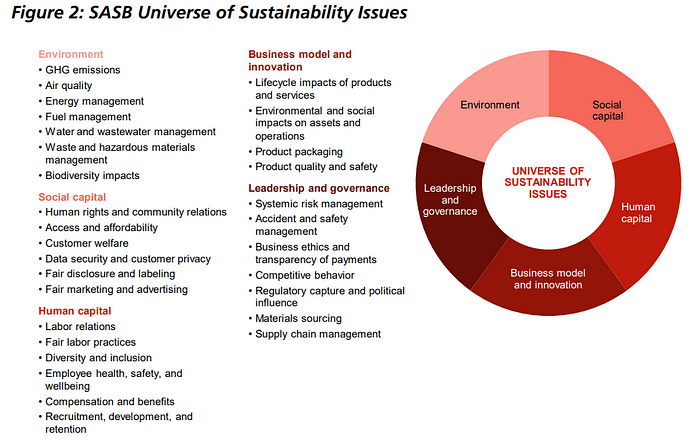Sustainability Reporting: Why Transparency is Always Appreciated
In the previous article, we broached the subject of Stakeholder Engagement and I promised to look further into the tools companies use to engage the variety of their stakeholders. One of such tools is Sustainability Reporting.
First and foremost, why such a thing as Sustainability Reporting even emerged? Which events triggered it?
It has started with governments and societies reacting to factors that jeopardized the social structures, the economy, and the environment, such as climate risks, energy, and food security, poverty, and financial crisis (the so-called, global megatrends). Therefore, an unprecedented wave of transformation of enterprises’ processes, behavior, and accountability for a sustainable future has started to be observed. That lead to the fact that planetary bounds have started to be taken into account when determining corporate effectiveness, as well as management objectives.
As Rachel Kyte, Vice President, Business Advisory Services, IFC has stated
“The last decade has seen a steady rise in public demand for businesses to be transparent about their environmental, social, and governance (ESG) performance, including their contributions to local economies. Companies worldwide have met this trend by increasing their uptake of what is now commonly called ‘sustainability reporting.”
Sustainability Reporting should be seen as a tool to dynamize the engagement between investors, businesses, and communities. After all, there is a clear link between good environmental, social and governance (ESG) performance and the ability of companies and organizations to be profitable and survive turbulent times.
What is Sustainability Reporting?
Sustainability Reporting is a form of internal monitoring, management, and external communication, which enables organizations of all sizes to meet the growing information needs of their various stakeholders. At the same time, it helps reinforce the internal capacity to engage the full organization in defining a corporate sustainability strategy, setting public targets, implementing plans, and reviewing results.
Sustainability Reporting is there to answer questions from a company’s stakeholders about key sustainability topics, such as relationships with local communities, protection of human rights, adaptation to climate change, and corporate governance performance. Simply put, the information contained in a sustainability report is the one that matters to stakeholders.
How and why did the Sustainability Reporting appear?
A change in perception about the role of the corporation and its new corporate design principles (Сorporation 2020) played a vital role in pushing for sustainability reporting globally. These new principles were based on the idea that a company’s purpose is to use private interests to serve the public interest, the so-called B Corporation and to benefit society, as well as the company’s shareholders.
The supranational authorities strove to reconcile business practices with the goals of sustainable development by, among other means, promoting the adoption of corporate reporting standards that require information related to sustainability from businesses.
On the other hand, as it has become more widely recognized that the long-term sustainability of a business is directly related to its ability to weather environmental and social trends, a number of key sustainability challenges have become areas of intense investor concern.
Advantages of implementing Sustainability Reporting
Sustainability Reporting is a journal that is meant to help companies cross the river of ever-changing corporate sustainability.
When done well, Sustainability Reporting serves as a business process that can create internal benefits. For example, it can help a company stimulate internal communication and alignment of vision, build management systems, develop staff competencies, and promote behavior change. It can be particularly useful in identifying gaps in existing practices and in focusing attention and resources on measuring and improving performance in line with corporate targets.
Sustainability integrated into reporting brings additional value due to the importance of adequate & timely disclosure, it also serves as a management tool that can help companies identify operational efficiency improvements, innovate the products and services, build stronger relationships with stakeholders, enhance reputation value and, as a consequence, attract investors.
Many leading companies cite the internal strategic value of reporting as one of its main benefits.
Why reporting on environmental, societal, and governance aspects?
- To provide investors with the information needed for making informed decisions. With a greater understanding of what makes a sustainable business, investors want to know that a company is not only financially strong but also whether it has properly taken into account, and has systems to manage, other aspects of its business.
- To increase the efficiency of capital allocation.
- To increase trust and transparency. Transparency is a fundamental component of good corporate governance and serves to build vital relationships of trust with key partners of any business.
- To keep track of corporate efforts to achieve sustainable economic, social and environmental development. Management errors across all dimensions of the business will be reflected in the results achieved either in terms of direct financial consequences or in the diminishment of key intangible assets, such as employee productivity, or tangible and measurable assets, such as customer loyalty.
- To enhance reputation value.
The quality of reporting is also (or even, first of all) a direct reflection of the company’s own grasp of its environmental and social performance.
Reporting also aims at uniting standardization, rationalization, and order.
The Most Influential Sustainability Reporting Standards
They are here to help you build or improve your own Sustainability Reports. So, let’s have a closer look:

The International Integrated Reporting Council (IIRC) is a global coalition of regulators, investors, companies, standard setters, the accounting profession, and NGOs. It is promoting communication about value creation as the next step in the evolution of corporate reporting. Its objective is to change the corporate reporting system so that integrated reporting becomes the global norm.
The IIRC aims to standardize the additional non-financial information that would further the understanding of the impact of a company’s overall strategy on its present and future financial condition as reported in its annual reports. It is not a proposal to integrate the sustainability report with the annual financial report, as many believe, but to integrate financial and non-financial information (their impact on the six capitals that the company manages) to present an integral view of the prospects of the company.
To show you how international the council is and how interconnected it all is, look at the participants of the Corporate Reporting Dialogue:
- Climate Disclosure Project;
- Climate Disclosure Standards Board;
- Financial Accounting Standards Board;
- Global Reporting Initiative;
- International Accounting Standards Board;
- International Organization for Standardization (ISO);
- Sustainability Accounting Standards Board.
The International Reporting Framework itself can be found here.
2. Sustainability Accounting Standards Board (SASB)

The Sustainability Accounting Standards Board (SASB) is an independent nonprofit organization. SASB’s mission is to develop and disseminate sustainability accounting standards that help public corporations disclose material, decision-useful information to investors. That mission is accomplished through a rigorous process that includes evidence-based research and balanced stakeholder participation. SASB standards are designed for voluntary use in disclosures required by existing U.S. regulation in filings with the Securities and Exchange Commission (SEC).
The SASB Framework can be found here.
In developing its provisional standards, the SASB identified sustainability topics from an initial set of 30 broadly relevant sustainability issues organized under these five sustainability dimensions.

3. Global Reporting Initiative (GRI)

Over the last decade, the GRI has established the international standard for sustainability reporting by organizations worldwide. It was established in 1997 with the vision that reporting on economic, environmental, and social performance by all organizations should become as routine and comparable as financial reporting.
In 2018, the GRI released the GRI Standard, now a globally recognized framework for sustainability reporting. Not only it sets out the principles and indicators that any organization can use to measure and report on its sustainability performance, but it also provides guidance to companies of different sizes and in different sectors on how to navigate the reporting process.
By using the guidelines of the GRI, a company covers the key issues that most stakeholders are concerned about, using the recognizable and understandable performance indicators, and reporting in a way that is comparable to its peers.
4. ISO Standard 26000 on Social Responsibility

This standard provides guidance on how businesses and organizations can operate in a socially responsible way.
ISO 26000:2010 provides guidance rather than requirements, so it cannot be certified to, unlike some other well-known ISO standards. Instead, it helps clarify what social responsibility is, helps businesses and organizations translate principles into effective actions, and shares best practices relating to social responsibility, globally. It is aimed at all types of organizations regardless of their activity, size, or location.
More information on the ISO 26000 Standard here.
All in all, the IIRC, SASB, and GRI focus on reporting through public channels that are widely defined by the IIRC and GRI, but the SASB results are aimed at mandatory reporting requirements in the United States. Other standards, such as the ISO 26000, focus mainly on actions and corporate behavior, not on reporting, although transparency is also encouraged there.
Civil society insists that better corporate responsibility and accountability have led to the launch of such initiatives as the Human Rights Due Diligence Project and Publish What You Pay.
Gender as part of sustainability reporting
While gender is also part of reporting on sustainability, it is often overlooked and deemed unimportant. I think this is because gender issues are still not associated with sustainability as such.
Up until very recently, there has been a limited level of coverage of gender issues in sustainability reports and specifically an unfrequent reporting of three gender-related indicators:
- Total number and rate of employee turnover by age group, gender, and region;
- Composition of governance bodies and breakdown of employees per category according to gender, age group, minority group membership, and other indicators;
- Ratio of the basic salary of men and women by employee category.
The case for promoting gender equality is based on multiple factors. Beyond a legal and moral imperative, there are also business reasons for doing so, such as improved reputation and employee morale, and attracting and keeping talented employees.
As you see, there are numerous factors to include into the company’s Sustainability Report to make it comprehensive for stakeholders, to give them grounds for informed decision-making, and even a range of standards to select from. It doesn’t matter too much which Standard or set of requirements the company uses to report its non-financial sustainability data, at least as long as there is some competition on the market between them (which is not always healthy). One thing we can be sure of is that honesty and transparency are always appreciated.
How does your company cope with Sustainability Reporting? Share with us in the comments.
Writer Anna Chashchyna
Editor Maria Isabel Acosta Lopez
